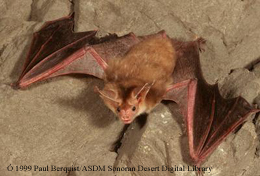Animal Fact Sheet: Pallid bat |
Identifying Features The Pallid bat (Antrozous pallidus) has yellowish brown to cream colored fur on its back and white fur on its belly. What is most noticeable about this bat are its large ears. The ears are almost half as long as the total length of its head and body. Also, its eyes are larger than most species of North American bats. |
 |
Migration/Hibernation Pallid bats do not appear to migrate any great distance as the seasons change. They will break into smaller groups and hibernate deep within crevices in canyon walls, in buildings or deep in caves where the temperature is more constant. |
Habitat The pallid bat is can be found found in arid regions with rocky outcroppings, to open, sparsely vegetated grasslands. Water must be available close by to all sites. They typically will use three different types of roosts. A day roost which can be a warm, horizontal opening such as in attics, shutters or crevices; the night roost is in the open, but with foliage nearby; and the hibernation roost mentioned above, which is often in buildings, caves, or cracks in rocks. |
Range They occur in arid and semi-arid regions across much of the American west, up and down the coast from Canada and Mexico. A few isolated colonies have been found in northern Oklahoma and southern Kansas. |
Wild Status Throughout it's range the pallid bat is considered a common species. There is some concern for this and all bats as they are sensitive to human encroachment. Human disturbance of roosting areas and pesticide use are of increasing concern. |
Diet Pallid bats will eat a variety of prey items. These can include crickets, scorpions, centipedes, ground beetles, grasshoppers, cicadas, praying mantis and long-horned beetles. They have been known to eat lizards and rodents. What is unique to the pallid bat is that it catches its food almost exclusively on the ground as opposed to while in flight. After catching its prey it will fly to a convenient location to consume its meal. |
Predators Because they capture their prey on the ground they are susceptible to predators on the ground. These can include cats, fox, racoon, snakes, coyotes and frogs. Owls also prey upon them while in flight. |
Reproduction Maternity colonies are rather small in size, ranging from 20-100 animals. Mating takes place in the fall resulting in usually two babies being born in the late spring. The pups begin to fly within five to six weeks. |
Life Span The pallid bat may live as many as10 years in the wild. |
Size Pallid bats weigh 0.7-1.2 oz (20-35g) and have a wingspan of 15-16 in (37-41 cm). |
Extra Fun-facts
|